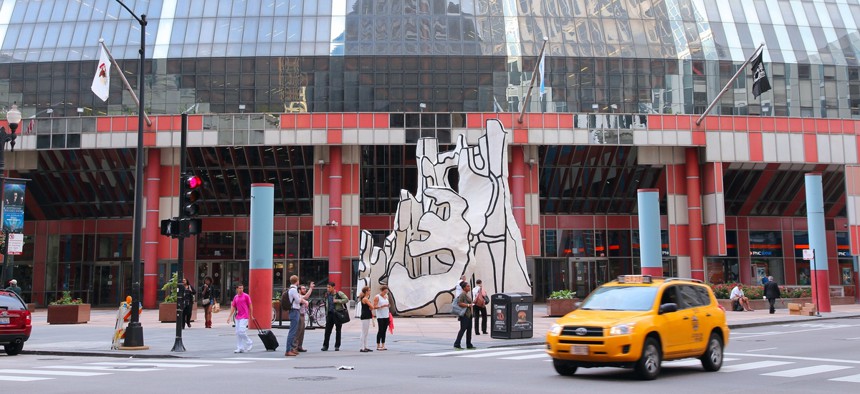Critical Condition: Here Are America’s Newest Endangered Historic Places

Chicago's Thompson Center is the youngest building ever to make the list. Tupungato/Shutterstock

Connecting state and local government leaders
The National Trust for Historic Preservation’s 2019 list of imperiled buildings, neighborhoods, and districts reveals the threats that older places face.
It’s a dangerous world out there for old buildings, but getting tagged as one of America’s 11 Most Endangered Historic Places can be a lifesaver. The National Trust for Historic Preservation, which has curated this annual count of critically threatened structures, neighborhoods, and historically significant sites since 1988, claims that only a handful of its listees—fewer than five percent—have succumbed to the wrecking ball. (RIP, Tiger Stadium.) As any bald eagle will tell you, landing on a list of endangered stuff has a way of rallying public opinion and catalyzing change.
“We’re looking for places where there’s some urgency, and where we can make a difference,” says Katherine Malone-France, the Trust’s interim chief preservation officer. “And also where the public can make a difference.”
This year’s list, as always, offers a glimpse into the varied forces that conspire to bring infrastructure down, from politics and obsolescence to of-the-moment threats like climate change and development pressure. Importantly, it also spotlights solutions: These spaces aren’t fundamentally doomed, says Malone-France. “There are pressure points that can be used here, and we want to raise the opportunity to do so. There are actions people can take. That’s the case with every place on this list—there are people locally working really hard to save them. Historic preservation is about solutions.”
Take Nashville’s Music Row, where the recording studios and offices of the 1950s country-music boom are braided into a residential neighborhood of 19th-century houses and bungalows. As the Tennessee capital experiences explosive economic and population growth, a wave of demolitions has struck these low-rise commercial buildings, setting up a familiar showdown between preservationists and build-more-housing forces over apartments towers vs. neighborhood character. A new “Vision Plan” for the area, as Curbedrecently reported, represents an effort to forge a compromise, and with a mayoral election coming in August, Malone-France hopes the Trust’s elevated concern can raise the political stakes and rally voters around saving the district.
Another city wrestling with change is Dallas, where the remains of the Tenth Street Historic District in South Dallas—first settled by formerly enslaved “Freedmen” after the Civil War, then savaged by highway construction in the 1950s—are slowly disappearing as dilapidated homes are targeted for demolition. More than 70 of the 260-odd structures in the district have been bulldozed, an erasure that Texas preservationists have been powerless to stop: The neighborhood may be landmarked, but structures of less than 3,000 square feet can be demolished by court order. It’s a textbook demolition-by-neglect saga, complicated by the fact that some residents and property owners are eager to be rid of their long-vacant homes, which have become magnets for squatters and vandalism. “This is one where it’s really important to raise the public profile,” Malone-France says.
In Buffalo, New York, demolition also looms for a New Deal-era landmark: the Willert Park Courts complex in the city’s East Side. New York State’s first public housing built for African Americans is a Modernist campus decorated with striking bas-relief sculptures created by artist Robert Cronbach, but it’s been empty and deteriorating for more than a decade; the Buffalo Municipal Housing Authority now plans to raze the entire complex.
Other notable entries this year include spaces where climate change serves as an existential threat: At Washington, D.C.’s Tidal Basin, a rising Potomac River is overwhelming the sea wall and engulfing monuments and walkways. In hurricane-ravaged Puerto Rico, one of the island’s oldest surviving coffee haciendas, Hacienda Los Torres, is now heavily damaged and in urgent need of restoration.
In Providence, Rhode Island, meanwhile, the state’s tallest skyscraper is menaced by a more ancient foe: functional obsolescence. The Industrial Trust Company Building is a 26-story, 380,000-square-foot Art Deco icon that’s known locally as the Superman Building, thanks to its resemblance to the comic’s Daily Planet tower. But its last tenant, Bank of America, left in 2013, and there’s no savior on the horizon. Hopes for converting the colossal office building into mixed-use retail and apartments, as many other cities have done, have stalled. As the city waits, developers circle with demolition proposals, and chunks of limestone are falling off the facade.
But there’s an even bigger white elephant/irreplaceable architectural milestone on this year’s list: Helmut Jahn’s James R. Thompson Center in Chicago. A city-block sized “Starship” clad in glass and built in 1985, it’s the youngest building the Trust has ever listed, and the first Postmodern addition to the Endangered Places canon. (And, given the enduring unpopularity of much ‘80s architecture, unlikely to be the last.) The State of Illinois is eager to unload this unloved behemoth, now home to state government offices; finding a new tenant willing to put up with its divisive aesthetics and temperamental HVAC system may be a mighty challenge.
But the Trust, at least, is willing to give it shot. “It’s an incredibly important example of Postmodernism, and we see Postmodernism and Brutalism as the next areas of preservation,” Malone-France says. “That’s one of the beautiful things about historic preservation—it keeps evolving as time passes.”
David Dudley is the executive editor of CityLab.

NEXT STORY: To Curb Trashcan Clutter, a City Will Try Stowing Waste Underground




